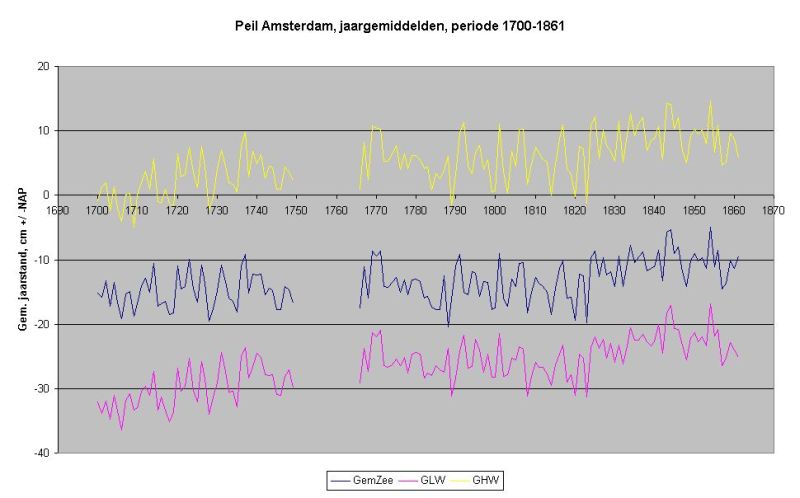The History of Dutch Ordnance Datum (NAP)
Frans J.P.M. Kwaad,
physical geographer
Home
By order of Johannes Hudde, Lord Mayor of the city of
Amsterdam and famous mathematician, in 1683, visible marks of the
already existing city's ordnance datum of Amsterdam (AP) were
established. For that
purpose Hudde had large, white marble stones installed in the walls of
eight sluices (locks) in the sea dyke running along the southern
waterfront of "het IJ". "Het IJ" was, and still is, a major
watercourse in Amsterdam; until 1932 it had an open connection with the
North Sea. On each of the marble stones a horizontal line was cut
representing the height of the top of the sea dyke. Only one of these
so-called Hudde stones still remains in place, in the Eenhoorn sluice.
The stone bears the following inscription: ZEE DYKS HOOGHTE, ZYNDE
NEGEN VOET VYF DUYM BOVEN STADTSPEYL. In translation it reads: SEA
DYKE'S
HEIGHT, BEING NINE FEET AND FIVE INCH ABOVE CITY DATUM. This means that
the horizontal line on the stone sits at an altitude of 2.676 m above
Amsterdam Ordnance Datum. In this way Amsterdam Ordnance Datum (or AP)
was represented by a mark for everyone to see. Since 1683 the
definition of AP (later NAP) is: a datum level
at 2.676 m below the horizontal line on
the Hudde stones. It is important to realize, that when AP was renamed
NAP in 1891, the original datum level was maintained.
The question arises, which stage or level of "het IJ"
corresponded
with Amsterdam Ordnance Datum in 1683. Was it mean sea level (half tide
level) or a different stage? From daily measurements of high and low
tide
near the Haarlemmer sluice in 1683-1684, it is known that Amsterdam
Ordnance Datum nearly coincided with mean summer high tide on "het IJ".
There is a difference of only 1.8 mm between the two. It can be safely
assumed, therefore, that mean summer high tide on "het IJ" was, in
fact, selected
as the city's ordnance datum in the seventeenth century.
The mean difference between high and low tide on "het IJ" amounted to
33.6 cm in 1683-1684. This means that mean sea level (or half tide
level) in those days was 17 cm below Amsterdam Ordnance Datum. By
relative sea level rise since then, mean sea level along the Dutch
North Sea coast at present is between 0 and 10 cm +NAP. This
varies slightly from place to place.
During the 18th century, especially in the years 1797-1812, AP was
transferred by geodetic levelling from Amsterdam to other locations in
the country where also AP marks were installed. By Royal Decree of 1818
it
was ordained that from then on AP should be used as Ordnance Datum
for the whole of the Netherlands, henceforth being Dutch Ordnance
Datum.
In the years 1875-1885, a first geodetic precision levelling was
carried out to check AP marks throughout the country. Five still
remaining Hudde stones were used as a reference during that measurement
campaign.
It appeared that not all AP marks and land surface elevations based on
those marks were at the right altitude, due to measurement errors and
vertical movements of the marks. New AP marks were installed, old ones
corrected and land surface elevations remeasured. AP (Amsterdams Peil)
was renamed NAP (Normaal Amsterdams Peil). As a result, since 1891,
terrain and
water heights in the Netherlands are given in m + or -
NAP.
In 2005 another correction on NAP-heights was carried out, but again
the original datum level was maintained.
More detailed information on the history of Dutch Ordnance Datum (NAP)
can be found on
Normaal
Amsterdams Peil
Below two pictures of the Eenhoornsluis with the last remaing Hudde
stone are shown:



